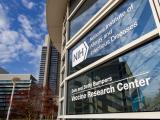Sep 22, 2008 (CIDRAP News) – The Congressional Budget Office (CBO) suggests in a new report that an increased focus on the development of vaccine adjuvants could save the US government money while improving the nation's preparedness for an influenza pandemic.
Noting that the government has been spending large amounts to increase egg-based flu vaccine production capacity and develop cell-based production capacity, the CBO says it might be wise to shift some funds into the development of adjuvants (chemicals that reduce the amount of vaccine needed to generate an immune response).
"The arithmetic of pandemic vaccination changes dramatically . . . if adjuvanted vaccines are developed and approved," says the report. If adjuvants fulfill their promise, it adds, the egg-based and cell-based production facilities now available or under construction would be enough to meet HHS's goal of vaccinating every US resident within 6 months of the start of a pandemic.
The CBO published its findings on Sep 15. The 52-page report gauges progress the Department of Health and Human Services (HHS) has made since 2005, when it outlined two main vaccine goals in its pandemic plan: to increase production capacity by 2011 to vaccinate the entire US population within 6 months of a pandemic onset and to stockpile enough vaccine to inoculate 20 million people shortly after a pandemic begins.
The report, requested by Senate Majority Leader Harry Reid, D-Nev., was written by Julie Somers and Philip Webre of the CBO's microeconomic studies division. The authors consulted government, industry, and academic experts, including David Fedson, MD, a retired professor of medicine from the University of Virginia and former researcher with Aventis Pasteur who is an internationally known vaccine expert.
Though the CBO offers a range of options for HHS officials to consider, it does make recommendations in the report. The CBO's task is to provide Congress with nonpartisan background information, estimates, and projections for economic and budget decisions.
Adjuvants change the dynamic
Additional spending will be needed to pursue federal pandemic vaccine goals, and HHS isn't likely to meet its goal of being able to immunize 300 million people by 2011 in the event of a pandemic, the authors write.
However, the CBO says the development of adjuvants could change the course of the government's pandemic vaccine policy. Clinical trials suggest that adjuvants could be used to stretch supplies of antigen. The current pandemic (H5N1) vaccine in the national stockpile provides "poor-to-moderate" protection with two 90-microgram (mcg) doses, but adjuvanted vaccine candidates have been shown to provide acceptable protection with two 3.8- to 7.5-mcg doses of antigen. Also, the CBO says that policymakers have more information now about pandemic vaccines than they did in 2005 when plans were released.
"Adjuvants developed since 2005 could substantially reduce the amount of antigen needed per dose, raising the question about whether HHS's current policy is the most cost-effective approach to meeting its vaccine production goals," CBO Director Peter R. Orszag wrote in a Sep 15 blog post that accompanied the report.
"An extrapolation of the results from clinical trials leads to the preliminary conclusion that, by 2011, domestic egg-based manufacturing could produce enough antigen within six months of the onset of a pandemic to immunize 225 million people with adjuvanted vaccines at 15 micrograms per dose," the report says. But if adjuvants are not used, the projected capacity would be enough to immunize only about 38 million people, it adds.
The CBO says the existing pandemic stockpile is about 26 million doses, but 15 million doses have expired, leaving about 11 million, or enough to vaccinate about 5.6 million people.
The CBO predicts that if adjuvants fulfill their promise, HHS officials could consider setting new goals for boosting domestic production capacity. For example, the report estimates that it would cost between $1.2 billion and $1.8 billion to build production facilities to make adjuvanted cell-based vaccines, but places the building cost for making nonadjuvanted cell-based vaccines at between $7.6 billion and $11.4 billion.
HHS policy focuses on cell-based vaccine production because it offers a potentially more reliable production method that does not depend on chicken eggs and can be more quickly ramped up to meet production needs in a pandemic setting.
The report says that having too much cell-based production capacity during nonpandemic years could create another cost. "To keep the factories ready to operate, continuing federal support—in the form of purchases for the stockpile or direct payments—would probably be necessary," it states. However, if capacity is reduced, the resulting reliance on a small number of manufacturers, especially those that rely on poultry flocks, raises the risk of supply disruption during a pandemic.
Counting all stockpiling costs
Most of the government's work on the pandemic vaccine has involved acquiring vaccine in the first place, but the CBO says the cost to replace expired vaccine and adjuvant could be significant, with an annual price tag ranging from $350 million to $1.1 billion. Assuming a 3-year shelf life for an adjuvant, the CBO puts the annual cost of maintaining the supply of both adjuvant and antigen at $350 million. However, without the use of adjuvants, the yearly cost for replacing necessarily greater quantities of expired antigen would rise to $1.1 billion.
Jeff Levi, executive director of Trust for America's Health, a nonprofit public health advocacy group based in Washington, DC, told CIDRAP News that the discussion of the continuing costs of the vaccine stockpile is one of the most interesting points of the CBO's report. The annual cost of maintaining the stockpile hasn't been factored into federal budget projections, he said.
"That's a large amount of money, and it's large in the public health world. We obviously need to address this issue as well," Levi said.
Replacement and shelf-life issues regarding antiviral stockpiles are fairly straightforward, but maintaining vaccine stocks is much more complex, he said, adding, "The up side is the vaccine supply may need to be replenished to adjust for mutations."
More for next-generation vaccines?
The HHS pandemic plan contains few incentives for firms to develop next-generation vaccines, such as those that use recombinant DNA techniques, the CBO reports. However, if the use of adjuvants allowed HHS to cut back on the amount of antigen in the stockpile and on building production capacity, this could free up more resources to support the development of next-generation vaccines.
Use of a safe and effective adjuvant could also stretch the vaccine supply to immunize well above HHS's initial goal of 20 million people at the start of a pandemic.
The reports draws a contrast between the US policy of direct support for vaccine manufacturers and Europe's model for building pandemic vaccine supply and capacity through advance supply agreements, under which governments make advance payments to guarantee a supply of vaccine in the event of a pandemic.
Although the US approach of subsidizing the development of production capacity could result in a greater supply of vaccine, it does not guarantee there would be enough: "Manufacturers could exhaust their supplies when filling their European agreements before they have a chance to sell any to the United States," the report says. On the other hand, with advance supply agreements, there is a risk that manufacturers won't have the capacity to fulfill them.
See also:
Sep 15 CBO report on US pandemic vaccine policy
Sep 15 CBO director blog post
2007 CIDRAP News series "The pandemic vaccine puzzle, Part 4: The promise and problems of adjuvants"


















